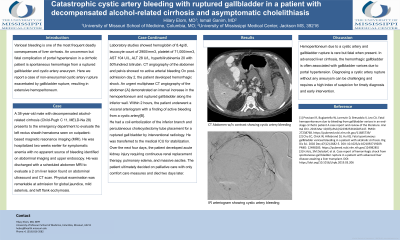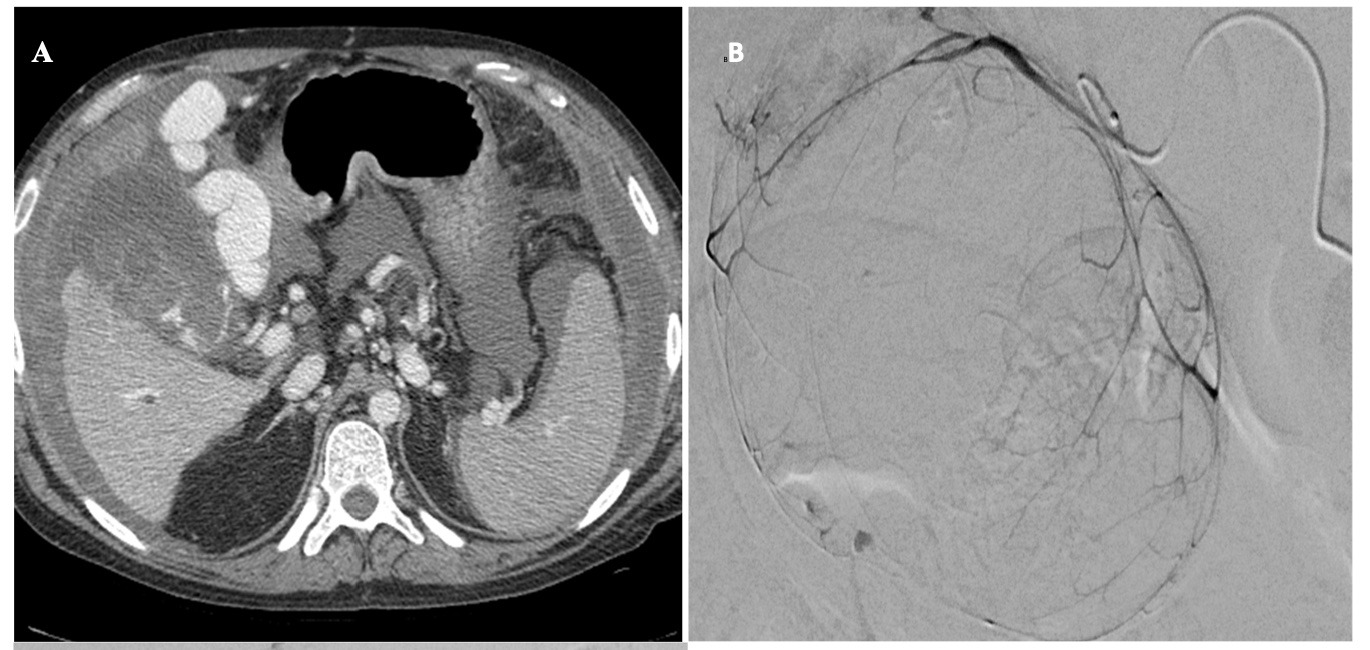Sunday Poster Session
Category: GI Bleeding
P0665 - Catastrophic Cystic Artery Bleeding With Ruptured Gallbladder in a Patient With Decompensated Alcohol-Related Cirrhosis and Asymptomatic Cholelithiasis
Sunday, October 22, 2023
3:30 PM - 7:00 PM PT
Location: Exhibit Hall


Hilary A. Elom, MD, MPH
University of Mississippi Medical Center
Columbia, MO
Presenting Author(s)
Hilary A. Elom, MD, MPH
University of Mississippi Medical Center, Jackson, MS
Introduction: Variceal bleeding is one of the most frequent deadly consequences of liver cirrhosis. An uncommon but fatal complication of portal hypertension in a cirrhotic patient is spontaneous hemorrhage from a ruptured gallbladder and cystic artery aneurysm. Here we report a case of non-aneurysmal cystic artery rupture exacerbated by gallbladder rupture, resulting in extensive hemoperitoneum.
Case Description/Methods: A 38-year-old male with decompensated alcohol-related cirrhosis (Child-Pugh C 11, MELD-Na 28) presents to the emergency department to evaluate the left rectus sheath hematoma seen on outpatient-based magnetic resonance imaging (MRI). He was hospitalized two weeks earlier for symptomatic anemia with no apparent source of bleeding identified on abdominal imaging and upper endoscopy. He was discharged with a scheduled abdomen MRI to evaluate a 2 cm liver lesion found on abdominal ultrasound and CT scan. Physical examination was remarkable at admission for global jaundice, mild asterixis, and left flank ecchymosis. Laboratory studies showed hemoglobin of 8.4g/dl, leucocyte count of 2900/mm3, platelet of 71,000/mm3, AST 104 U/L, ALT 28 U/L, hyperbilirubinemia 20 with 50%indirect bilirubin. CT angiography of the abdomen and pelvis showed no active arterial bleeding. On post-admission day 2, the patient developed hemorrhagic shock. An urgent multiphase CT angiography of the abdomen [A] demonstrated an interval increase in the hemoperitoneum and ruptured gallbladder along the inferior wall. Within 2 hours, the patient underwent a visceral arteriogram with a finding of active bleeding from a cystic artery[B]. He had a coil embolization of the inferior branch and percutaneous cholecystectomy tube placement for a ruptured gall bladder by interventional radiology. He was transferred to the medical ICU for stabilization. Over the next four days, the patient developed acute kidney injury requiring continuous renal replacement therapy, pulmonary edema, and massive ascites. The patient ultimately decided on palliative care with only comfort care measures and died two days later.
Discussion: Hemoperitoneum due to a cystic artery and gallbladder rupture is rare but fatal when present. In advanced liver cirrhosis, the hemorrhagic gallbladder is often associated with gallbladder varices due to portal hypertension. Diagnosing a cystic artery rupture without any aneurysm can be challenging and requires a high index of suspicion for timely diagnosis and early intervention.

Disclosures:
Hilary A. Elom, MD, MPH. P0665 - Catastrophic Cystic Artery Bleeding With Ruptured Gallbladder in a Patient With Decompensated Alcohol-Related Cirrhosis and Asymptomatic Cholelithiasis, ACG 2023 Annual Scientific Meeting Abstracts. Vancouver, BC, Canada: American College of Gastroenterology.
University of Mississippi Medical Center, Jackson, MS
Introduction: Variceal bleeding is one of the most frequent deadly consequences of liver cirrhosis. An uncommon but fatal complication of portal hypertension in a cirrhotic patient is spontaneous hemorrhage from a ruptured gallbladder and cystic artery aneurysm. Here we report a case of non-aneurysmal cystic artery rupture exacerbated by gallbladder rupture, resulting in extensive hemoperitoneum.
Case Description/Methods: A 38-year-old male with decompensated alcohol-related cirrhosis (Child-Pugh C 11, MELD-Na 28) presents to the emergency department to evaluate the left rectus sheath hematoma seen on outpatient-based magnetic resonance imaging (MRI). He was hospitalized two weeks earlier for symptomatic anemia with no apparent source of bleeding identified on abdominal imaging and upper endoscopy. He was discharged with a scheduled abdomen MRI to evaluate a 2 cm liver lesion found on abdominal ultrasound and CT scan. Physical examination was remarkable at admission for global jaundice, mild asterixis, and left flank ecchymosis. Laboratory studies showed hemoglobin of 8.4g/dl, leucocyte count of 2900/mm3, platelet of 71,000/mm3, AST 104 U/L, ALT 28 U/L, hyperbilirubinemia 20 with 50%indirect bilirubin. CT angiography of the abdomen and pelvis showed no active arterial bleeding. On post-admission day 2, the patient developed hemorrhagic shock. An urgent multiphase CT angiography of the abdomen [A] demonstrated an interval increase in the hemoperitoneum and ruptured gallbladder along the inferior wall. Within 2 hours, the patient underwent a visceral arteriogram with a finding of active bleeding from a cystic artery[B]. He had a coil embolization of the inferior branch and percutaneous cholecystectomy tube placement for a ruptured gall bladder by interventional radiology. He was transferred to the medical ICU for stabilization. Over the next four days, the patient developed acute kidney injury requiring continuous renal replacement therapy, pulmonary edema, and massive ascites. The patient ultimately decided on palliative care with only comfort care measures and died two days later.
Discussion: Hemoperitoneum due to a cystic artery and gallbladder rupture is rare but fatal when present. In advanced liver cirrhosis, the hemorrhagic gallbladder is often associated with gallbladder varices due to portal hypertension. Diagnosing a cystic artery rupture without any aneurysm can be challenging and requires a high index of suspicion for timely diagnosis and early intervention.

Figure: A. CTA abdomen showing bleeding cystic artery and ruptured gallbladder
B. IR angiogram demonstrating bleeding cystic artery
B. IR angiogram demonstrating bleeding cystic artery
Disclosures:
Hilary Elom indicated no relevant financial relationships.
Hilary A. Elom, MD, MPH. P0665 - Catastrophic Cystic Artery Bleeding With Ruptured Gallbladder in a Patient With Decompensated Alcohol-Related Cirrhosis and Asymptomatic Cholelithiasis, ACG 2023 Annual Scientific Meeting Abstracts. Vancouver, BC, Canada: American College of Gastroenterology.
